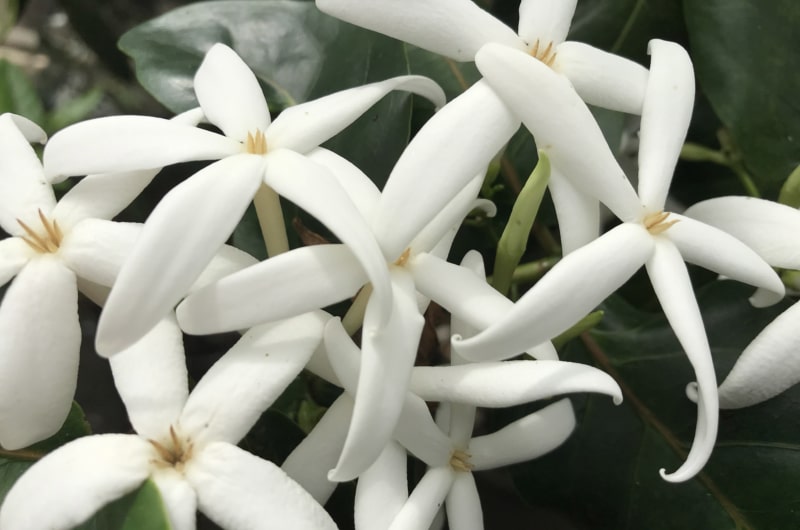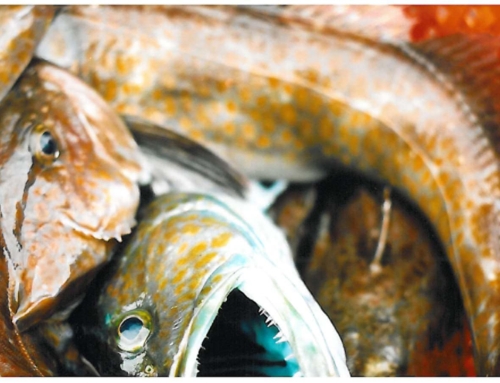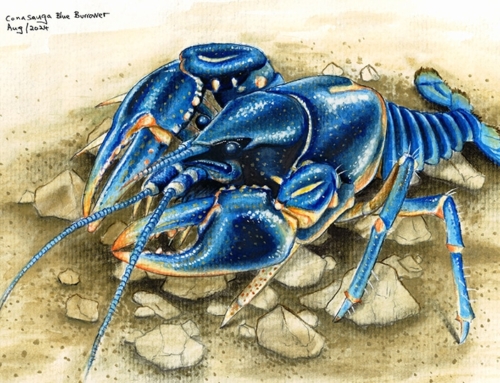This summer, thousands of people are streaming through the gates of Kew Gardens for the widely advertised Chihuly exhibition of huge colourful sculptures inspired by natural patterns. But when Synchronicity Earth’s staff visited last week, they were led past the glass Sapphire Star by Kew’s research team, who showed them the science and conservation behind the scenes at the renowned botanical gardens.
We asked our team about the most memorable moments from the day and collected five facts we didn’t know about plants and botanical conservation.
Gruesome carnivores or just… toilets?

Nepenthes veitchii, a tropical pitcher plant discovered in Borneo that lives 20—100 feet high on tree trunks. Image © Nina Seale
Tropical pitcher plants (Nepenthes) belong in the same exciting category as the Venus Flytrap: carnivorous plants. Many of the pitcher-shaped traps contain a syrupy fluid which attracts insect prey, who fall in and cannot climb back out the slippery sides of the pitcher. However, some pitcher plants have evolved a much less gruesome ecological service; they serve as botanical toilets!
Small animals such as rodents are lured to the lip of the pitcher and the plant digests the urine and faeces which drop into the bowl. It is believed that this is the primary purpose of some larger species, although sometimes rodent bodies can be found inside, completely digested except for the bones. One pitcher has adapted to serve as a roost for the Hardwicke’s woolly bat, providing shelter for the bat and receiving additional nitrogen from the bat faeces.
2,000 new plant discoveries each year

Kew’s Herbarium contains plants that have been collected around the world over the past 170 years. Image © Nina Seale
Dr Eimear Nic Lughadha, Senior Research Leader at Kew, nonchalantly dropped into the conversation that more than 2,000 new species of vascular plants have been described every year over the past decade. She showed the SE staff around the Herbarium (a vast library of preserved plants complete with red spiral staircases that could have come from a film set) and proudly pointed out specimens which had been collected by Charles Darwin himself.
“The herbarium keeps growing because we haven’t finished discovering the plant diversity of the world, and we want it to represent the world of plant diversity.”
Eimear Nic Lughadha
The herbarium samples are an invaluable resource into botanical history and provide resources for biologists and conservationists around the world.
Discoveries by a female Victorian explorer

The Marianne North Gallery paintings depict more than 900 species of plants, perfectly blending beauty and science. Image © Jon Southcoasting
Hidden in the southernmost corner of Kew is a red brick building which would easily be missed by visitors heading for the glasshouses or treetop walkway, but contains a treasure trove of wildlife art.
The Marianne North Gallery is filled, from floor to ceiling, with 832 vivid paintings by the female Victorian explorer it is named after, from all around the world. In an age before colour photography, her gallery provided people with a glimpse of plants inaccessible to most people. They were also so detailed that some paintings led to new botanical discoveries, including the largest known carnivorous pitcher plant (one of five plants that were named after her, Nepenthes northiana).
Kew’s gold reserve
David Attenborough has called the Millenium Seed Bank Partnership “perhaps the most important conservation initiative ever”. This partnership includes 121 organisations in 96 countries and has banked 16% of the world’s bankable plant species (48,000 species) to date. This genetic gold reserve provides a safety net, not just for the plant species at risk of extinction, but for whole ecosystems to which plants provide the foundation.
Plant conservation: where, not what
Plant biodiversity is so vast, and so much of it undiscovered, that plant conservation is moving towards a site-based, rather than species-based approach. The major threat to plants is land use change (such as deforestation for agriculture or livestock grazing) and the rapid loss of natural habitat in the tropics is currently the greatest threat to plant species. Kew’s scientists have established a framework to identify Tropical Important Plant Areas to prioritise the most unique and rich plant habitats for conservation.
These Tropical Important Plant Areas only have a 53% overlap with Important Bird Areas, which means that endangered plants are slipping through the cracks of bird-focused conservation efforts. For example, there is a plant colloquially known as the “orchid of the waterfalls” that only lives in waterfalls in Guinea, West Africa, and is highly threatened by hydropower development.
Kew’s extraordinary legacy

Café marron was rediscovered in the wild by a schoolboy, but the plant he found was the only one left in the world. Image © Nina Seale
Kew Botanic Gardens will be celebrating its 260th birthday this year. This institution is so much more than one of London’s most beautiful attractions- it has contributed ground-breaking advances in plant conservation. In addition to the Millenium Seed Bank and Tropical Important Plant Area initiatives, there have been extraordinary achievements for individual plants.
The delicate flowers of the café marron (Ramosmania rodriguesi) were once described as the ‘living dead’ as only one, infertile plant was left of the species. More than two decades after this single ‘zombie’ was discovered, a scientist from Kew managed to make it bear fruit with viable seeds.
However, despite the UK’s pioneering place in botanical history, plant conservation is slipping from the nation’s list of priorities. After the visit Simon Stuart, Synchronicity Earth’s Director of Strategic Conservation, said “I couldn’t believe that DEFRA (the government Department for Environment, Food and Rural Affairs) now funds only around 40% of Kew’s operation. This is a shocking reduction over the last 10 years. I think that Kew is a wonderful institution that could easily be destroyed and would be impossible to rebuild. It needs much more public sector investment. Just think of all the good things that spin-off from Kew’s work (and incidentally does a lot of good for the UK’s overall image).”
With around one in five plant species estimated to be threatened with extinction worldwide, Kew’s work recording and conserving plant species is more important than ever.
Support their efforts by visiting the botanic gardens at Kew or Wakehurst, or find out more about their conservation and research programmes on the Kew Science website.





